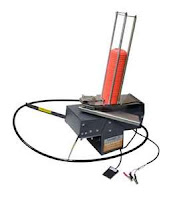
Shooting
is fun; whether shooting bows, pistols, rifles, shotguns, slingshots, marbles, or rubberbands. We have a great variety of ammunition for each type of gun. I've read that in man's early history, some men were better meat gatherers than land tillers or herders. (or tax collectors) Maybe that explains the presence and popularity of so many weapons in the United States. Humm... Back to my article.

I guess the shooter has to decide whether to specialize in one specific gun and ammunition or to shoot a wider variety of guns and ammunition. Even though I am very competitive, I've chosen the middle ground: limiting myself to sporting clays and using several different gauges and different guns. How, do you ask, can I become a competent shooter by switching guns each round each different day? Good question. I still get frustrated when my scores are not very consistent, but I get pure joy and satisfaction just shooting with great friends. I worked inside for 38 years and shooting sporting clays is a great release. I've observed contestants at big events literally shaking between shots. Why would I want that much pressure again like teaching and coaching?
I would be the first to admit that I do receive satisfaction when I beat someone when I shoot a .410 gauge and they shoot a 12 gauge. Ha! I have found out, however, that I do shoot my 12 gauge much better after a completing a round with a smaller gauge gun.
Now, back to the title of this post. To prevent boredom and to satisfy my scientific mind, I have worked on the following procedures:
- Changed choke tubes according to the target's distance and presentation.
- Used the same choke tubes regardless of the target's distance and presentation. Both open, or both skeet, or both I.C., or both Mod. I even mixed them all at random.
- Compared the ability of shot sizes #7 1/2, #8, and #9 to break targets.
- Compared Clays, Longshot, Red Dot, Universal Clays, Winchester Lite, and Unique powders in ease of reloading and "bang" factor when shooting.
- Recently, shot 1 ounce 12 gauge and 7/8 ounce 12 gauge loads.
- Shot guns with shorter barrels compared to guns with longer barrels.
- Spun around to the left before shooting at each station. (You think? Ha!)
- Visualized the breaking point of the target, took 2 deep breaths, (got dizzy) practiced mounting the gun before the shot, and told myself I would break the target, and drank coffee only after I had completed the round. (Been reading too much, huh?)
Wow! Sounds like a mess doesn't it? I have settled on certain results of this haphazard testing: I do carry cartridges loaded with # 7 1/2, #8, and #9 sized shot for closer or more distant targets. The # 8 and #9 shot is loaded with Winchester Lite powder with published recipes for 1 ounce and 7/8 ounce loads. I use mostly I.C. choke tubes, but keep Mod choke tubes available for longer shots. I found using skeet or open chokes didn't help me break more targets significantly. I also chose Unique powder as the major propellent because I found good Unique recipes for the 12, 16, and 20 gauges. I did find it easier to shoot lighter, shorter guns, but longer guns fit me better and therefore I broke more targets with them. In a later post, I will discuss my adventures with different brands of guns. If you are having a bad day, try spinning around to the left at each station. Ha! Believe it or not, I have seen shooters start hitting targets again following this technique. Do you think relaxing helps?
What are some of your preferences? Is there anything I missed?
I just spent several paragraphs and too many word for my 60 year old mind to handle coming to two final ideas: C O N F I D E N C E! C O M F O R T! If I am confident and comfortable with whatever groups of variables I am using while shooting, I do break more targets more consistently. Some of the "old guys" I shoot with say "Do what works for you." Maybe some day I will really get serious.

I was observing a grandfather giving his grandson tips on shooting techniques, "Place your left foot forward." "Put 70% of your weight on your left foot." "Crouch by bending your knees to a 1/4 squat." "Call for the target", etc, etc. When the young boy didn't call for the target, grandpa was puzzled. "What's your problem, son?" "Can't move!" said the boy. Ha! Ever been there?
At least I don't get bored, and I can blame missing a target on "Darn Brownings", "Too long a shot for a .410 gauge.", "Condors are junk!", or "Oops, I had the wrong choke in the gun."
What is my next shooting gripe? Manufacturers not making more new true 16 gauge guns, ammo, and reloading supplies. We all can't afford those old "sweet 16's"
Have fun! Keep "shootin".














































